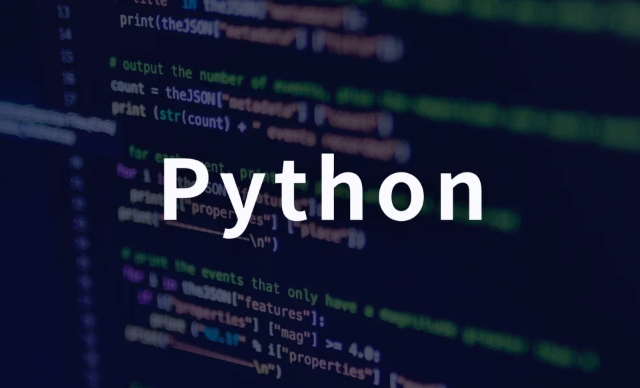Use uuid.uuid4() to generate random UUIDs, suitable for most unique ID scenarios; 2. Use uuid.uuid1() to generate ordered IDs based on timestamps and MAC addresses, but may expose host information; 3. Use uuid.uuid5() or uuid.uuid3() to generate deterministic UUIDs based on namespace and names, and the same input produces the same output, suitable for scenarios where fixed IDs are required; 4. You can generate unique file names in combination with str(uuid.uuid4()).replace("-","") or uuid.uuid4().hex to obtain compact format IDs without hyphens, suitable for scenarios where short strings are required.

In Python, the uuid module is used to generate a universally unique identification code (Universally Unique Identifier), which is often used to generate unique IDs, such as database primary key, session ID, file name, etc. Below are some common examples of using uuid .

1. Generate UUID4 (random UUID)
This is the most commonly used type, generating a unique ID based on random numbers.
import uuid # Generate a random UUID id = uuid.uuid4() print(id) # The output is similar: f47ac10b-58cc-4372-a567-0e02b2c3d479 print(str(id)) # Convert to string
Suitable for most scenarios, such as generating temporary tokens, unique file names, etc.
2. Generate UUID1 (based on timestamp and MAC address)
UUID1 is generated using timestamps and the MAC address of the device, and is chronological.
import uuid id = uuid.uuid1() print(id) # The output is similar: 23f0f8f8-1a2b-11ef-ba4e-0242ac130002
Note: Host information (such as MAC address) may be exposed, and be used with caution in privacy-sensitive scenarios.
3. Generate UUID3 or UUID5 (hash based on namespace and name)
- UUID3 uses MD5 hashing
- UUID5 uses SHA-1 hash
Suitable for scenarios where "deterministic" output is required: Same input → Same UUID.
import uuid # Define the namespace (can be customized or use built-in such as uuid.NAMESPACE_DNS) namespace = uuid.NAMESPACE_DNS name = "example.com" # Use UUID5 (recommended, safer than UUID3) id5 = uuid.uuid5(namespace, name) print(id5) # The result is the same every time you run# Use UUID3 (MD5) id3 = uuid.uuid3(namespace, name) print(id3)
It is often used in a service where a fixed unique ID is needed for a certain name, such as user ID and configuration item ID.
4. Practical application example: Generate a unique file name
import uuid
def generate_unique_filename(suffix=".txt"):
return str(uuid.uuid4()) suffix
filename = generate_unique_filename(".jpg")
print(filename) # For example: a1b2c3d4-e5f6-7890-g1h2-i3j4k5l6m7n8.jpg5. Remove hyphen (compact format)
Sometimes shorter strings (such as database keys):
import uuid
id = uuid.uuid4()
compact_id = str(id).replace("-", "")
print(compact_id) # For example: f47ac10b58cc4372a5670e02b2c3d479 Or use the .hex property:
print(id.hex) # Also output hexadecimal string without hyphen
Basically these common uses. Just select the appropriate UUID type according to your needs.
The above is the detailed content of python uuid example. For more information, please follow other related articles on the PHP Chinese website!

Hot AI Tools

Undress AI Tool
Undress images for free

Undresser.AI Undress
AI-powered app for creating realistic nude photos

AI Clothes Remover
Online AI tool for removing clothes from photos.

Clothoff.io
AI clothes remover

Video Face Swap
Swap faces in any video effortlessly with our completely free AI face swap tool!

Hot Article

Hot Tools

Notepad++7.3.1
Easy-to-use and free code editor

SublimeText3 Chinese version
Chinese version, very easy to use

Zend Studio 13.0.1
Powerful PHP integrated development environment

Dreamweaver CS6
Visual web development tools

SublimeText3 Mac version
God-level code editing software (SublimeText3)
 How to handle API authentication in Python
Jul 13, 2025 am 02:22 AM
How to handle API authentication in Python
Jul 13, 2025 am 02:22 AM
The key to dealing with API authentication is to understand and use the authentication method correctly. 1. APIKey is the simplest authentication method, usually placed in the request header or URL parameters; 2. BasicAuth uses username and password for Base64 encoding transmission, which is suitable for internal systems; 3. OAuth2 needs to obtain the token first through client_id and client_secret, and then bring the BearerToken in the request header; 4. In order to deal with the token expiration, the token management class can be encapsulated and automatically refreshed the token; in short, selecting the appropriate method according to the document and safely storing the key information is the key.
 Explain Python assertions.
Jul 07, 2025 am 12:14 AM
Explain Python assertions.
Jul 07, 2025 am 12:14 AM
Assert is an assertion tool used in Python for debugging, and throws an AssertionError when the condition is not met. Its syntax is assert condition plus optional error information, which is suitable for internal logic verification such as parameter checking, status confirmation, etc., but cannot be used for security or user input checking, and should be used in conjunction with clear prompt information. It is only available for auxiliary debugging in the development stage rather than substituting exception handling.
 What are python iterators?
Jul 08, 2025 am 02:56 AM
What are python iterators?
Jul 08, 2025 am 02:56 AM
InPython,iteratorsareobjectsthatallowloopingthroughcollectionsbyimplementing__iter__()and__next__().1)Iteratorsworkviatheiteratorprotocol,using__iter__()toreturntheiteratorand__next__()toretrievethenextitemuntilStopIterationisraised.2)Aniterable(like
 What are Python type hints?
Jul 07, 2025 am 02:55 AM
What are Python type hints?
Jul 07, 2025 am 02:55 AM
TypehintsinPythonsolvetheproblemofambiguityandpotentialbugsindynamicallytypedcodebyallowingdeveloperstospecifyexpectedtypes.Theyenhancereadability,enableearlybugdetection,andimprovetoolingsupport.Typehintsareaddedusingacolon(:)forvariablesandparamete
 How to iterate over two lists at once Python
Jul 09, 2025 am 01:13 AM
How to iterate over two lists at once Python
Jul 09, 2025 am 01:13 AM
A common method to traverse two lists simultaneously in Python is to use the zip() function, which will pair multiple lists in order and be the shortest; if the list length is inconsistent, you can use itertools.zip_longest() to be the longest and fill in the missing values; combined with enumerate(), you can get the index at the same time. 1.zip() is concise and practical, suitable for paired data iteration; 2.zip_longest() can fill in the default value when dealing with inconsistent lengths; 3.enumerate(zip()) can obtain indexes during traversal, meeting the needs of a variety of complex scenarios.
 Python FastAPI tutorial
Jul 12, 2025 am 02:42 AM
Python FastAPI tutorial
Jul 12, 2025 am 02:42 AM
To create modern and efficient APIs using Python, FastAPI is recommended; it is based on standard Python type prompts and can automatically generate documents, with excellent performance. After installing FastAPI and ASGI server uvicorn, you can write interface code. By defining routes, writing processing functions, and returning data, APIs can be quickly built. FastAPI supports a variety of HTTP methods and provides automatically generated SwaggerUI and ReDoc documentation systems. URL parameters can be captured through path definition, while query parameters can be implemented by setting default values ??for function parameters. The rational use of Pydantic models can help improve development efficiency and accuracy.
 How to test an API with Python
Jul 12, 2025 am 02:47 AM
How to test an API with Python
Jul 12, 2025 am 02:47 AM
To test the API, you need to use Python's Requests library. The steps are to install the library, send requests, verify responses, set timeouts and retry. First, install the library through pipinstallrequests; then use requests.get() or requests.post() and other methods to send GET or POST requests; then check response.status_code and response.json() to ensure that the return result is in compliance with expectations; finally, add timeout parameters to set the timeout time, and combine the retrying library to achieve automatic retry to enhance stability.
 Setting Up and Using Python Virtual Environments
Jul 06, 2025 am 02:56 AM
Setting Up and Using Python Virtual Environments
Jul 06, 2025 am 02:56 AM
A virtual environment can isolate the dependencies of different projects. Created using Python's own venv module, the command is python-mvenvenv; activation method: Windows uses env\Scripts\activate, macOS/Linux uses sourceenv/bin/activate; installation package uses pipinstall, use pipfreeze>requirements.txt to generate requirements files, and use pipinstall-rrequirements.txt to restore the environment; precautions include not submitting to Git, reactivate each time the new terminal is opened, and automatic identification and switching can be used by IDE.








